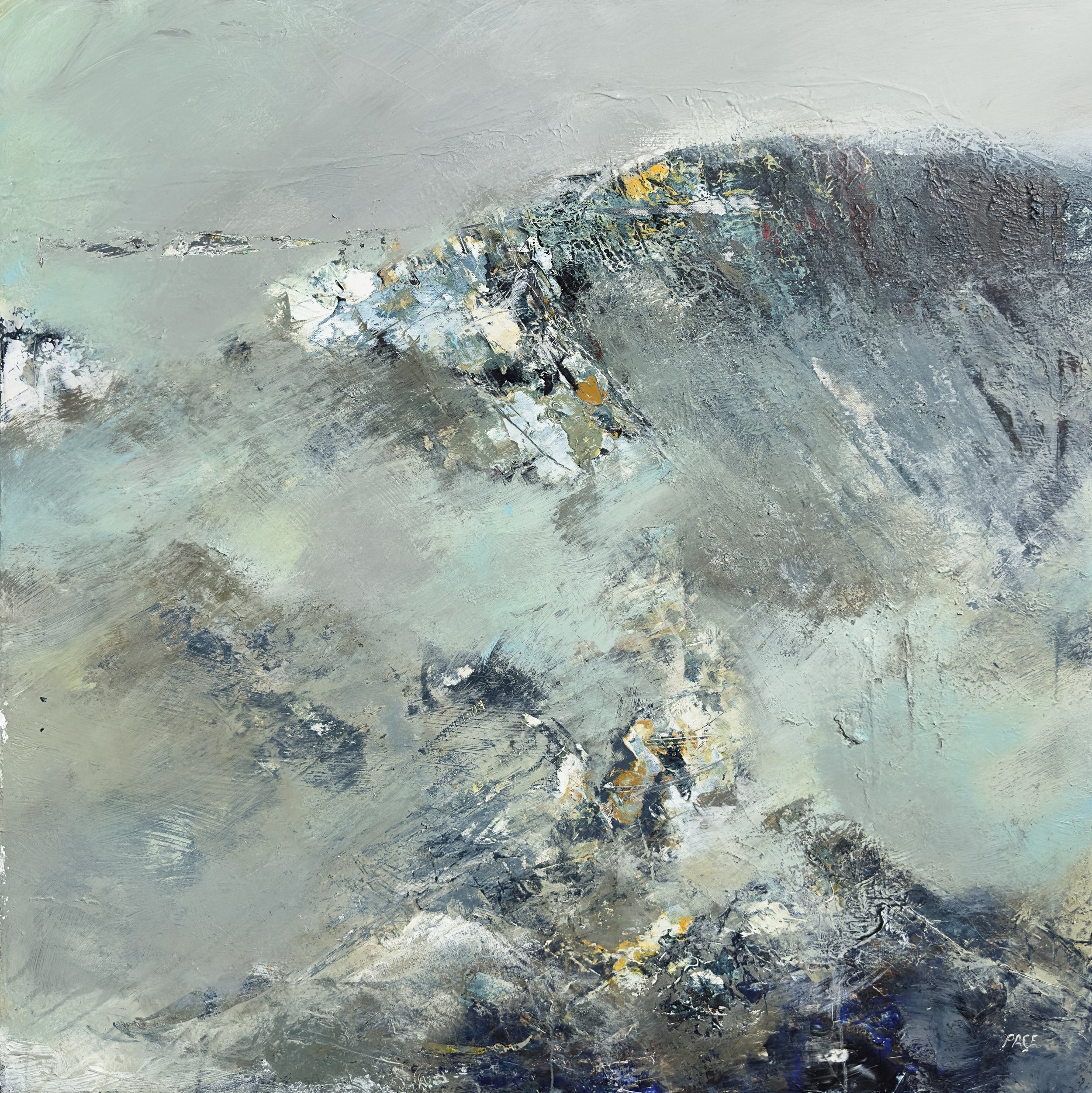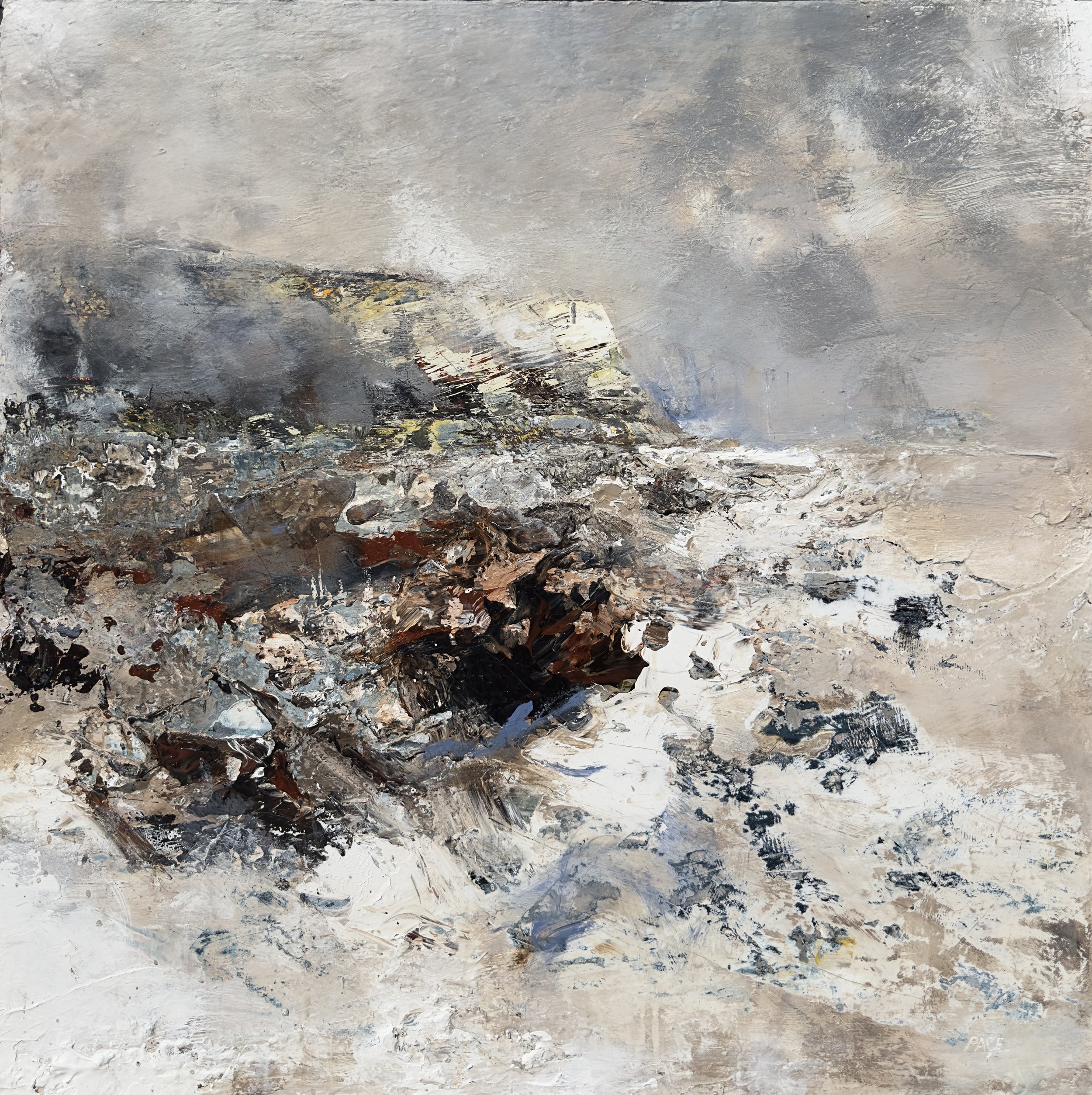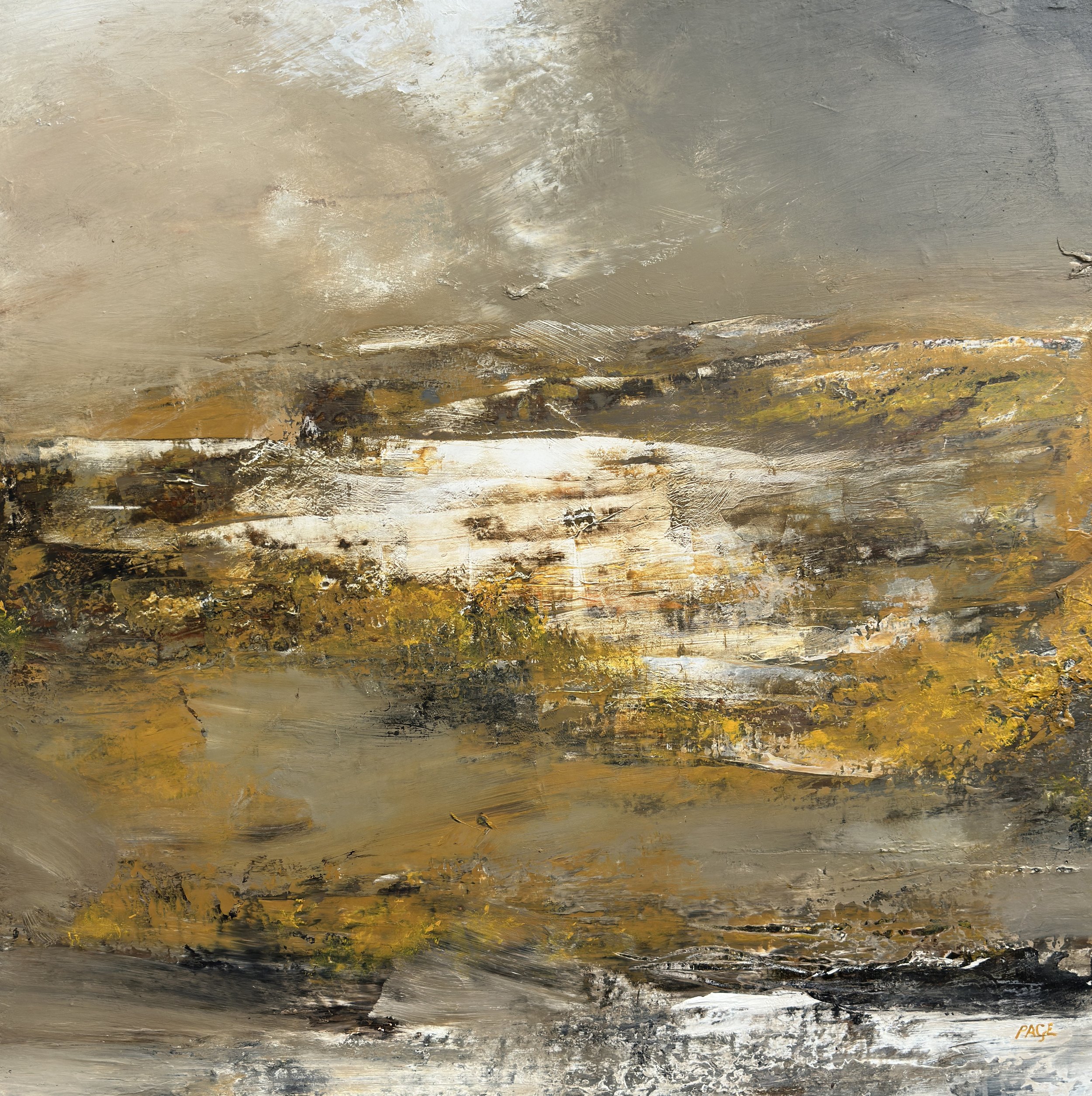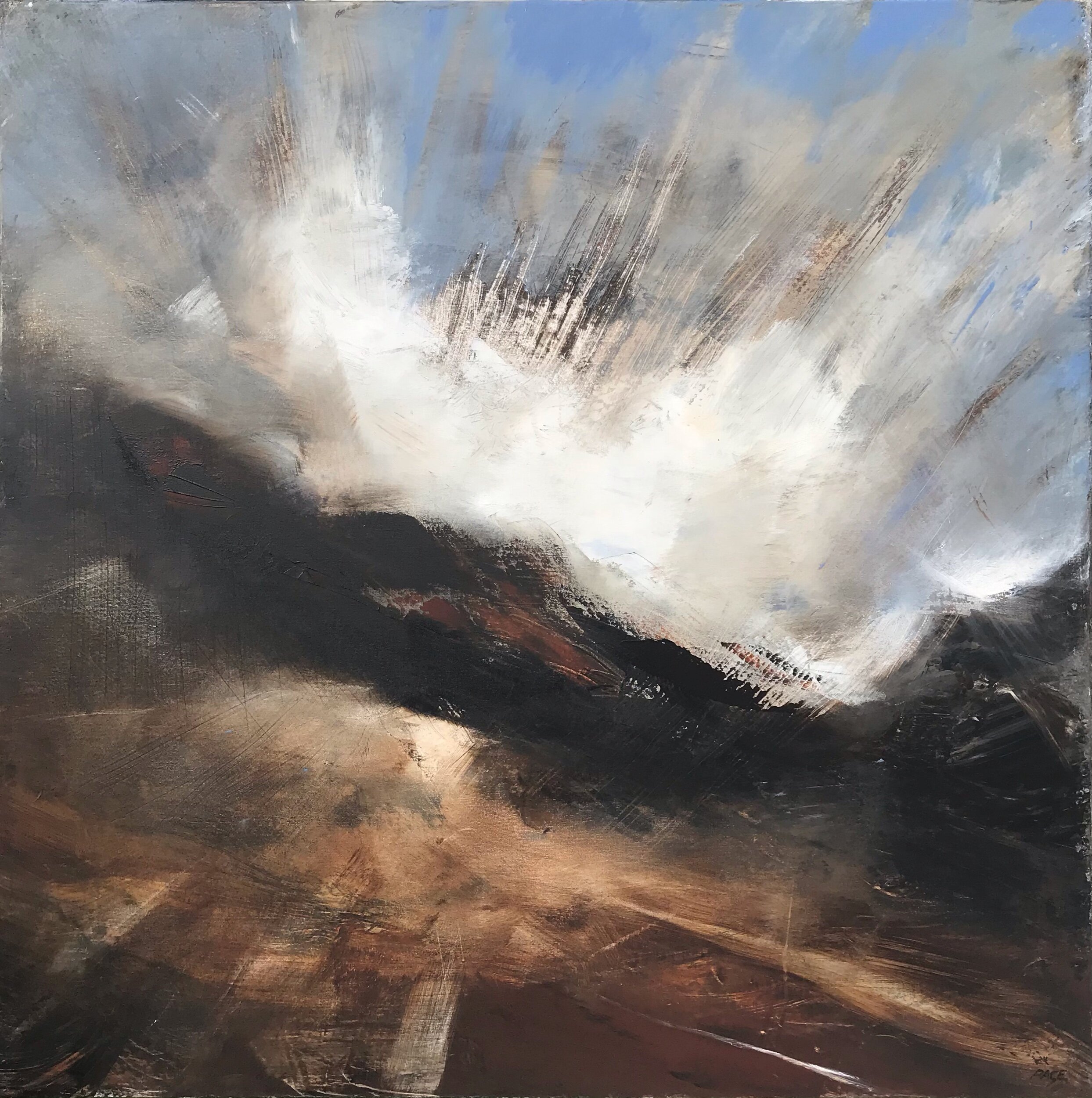An exhibition at Calgary Arts from 31st May to 8th June 2025 exploring Ben More in paint, the highest peak on the Isle of Mull.
Swathed
1000 x 1000 Acrylic on Canvas
Sold
As children, we’re often drawn to the idea of collections. In my day, it was toy cars, Airfix models, or football cards. As I grew older, that instinct evolved — first into art and architecture books shaping also my professional practice as an architect, then into visiting cities, ticking off notable buildings and artworks, and, more prosaically, walking up hills. My own collection of hill walks, before heart issues curtailed such ventures, was modest. But each climb left an indelible memory: a day stepping away from the city, into the wild, exposed to the elements — and ultimately, on top of everything.
There are many collectors of mountain conquests, and Scotland offers a particular kind of paradise for them. Sir Hugh Munro’s first listing of hills over 3,000 feet — now known as Munros — created a national pastime. Not to be outdone, John Corbett and Percy Donald added their own collections: the Corbetts (over 2,500 feet) and the Donalds (over 2,000 feet). The Scottish hills, in their variety and accessibility, are a collector’s dream — each one climbable in a day, yet deeply memorable.
For the extreme Munro collectors — like Hamish Brown, who climbed them all in a single continuous journey — the goal has always been completion. Some have done them all in winter. Some have run them. Some have completed multiple rounds. The determination and drive behind these personal quests to complete the collection is part of what makes the Munros such a compelling cultural phenomenon.
In that set, Ben More on the Isle of Mull holds a unique place. It is the only Munro on a standalone island — Skye, by contrast, is now linked to the mainland by a bridge. Hamish Brown began his legendary Munro round here, but for many climbers, Mull’s distinct character makes Ben More the ideal candidate to be the final summit in their collection — the Last Munro.
Homage
1000 x 1000 Acrylic on Canvas
Huddled
1000 x1000 Acrylic on Canvas
Sold
Regal
1200 x 1200 Acrylic on Canvas
Sold
Embracing
1500 x 1500 Acrylic on Canvas
At its peak, Ben More rewards the climber with a spectacular panorama: Jura and Colonsay lie to the south; the scattered rocks of the west sweep out past Iona and its abbey to the islands of Tiree and Coll, with Skerryvore Lighthouse flickering between. Closer in, Ulva and the Treshnish Isles are framed by Mull’s rugged edge, while to the east, a dramatic volcanic core rises in ridges and outcrops — a geological architecture of sorts, shaped by time and weather, not human hands.
The idea for this series came from my neighbour and fellow artist in Tobermory, Angus Stewart. Stewart has painted Ben More many times over the years, and his recent painting of the south face has become a popular print for visitors. Knowing my fascination with esoteric collecting, he generously passed the baton — or the mountain — into my not-entirely-safe hands.
Fractured
1000 x 1000 Acrylic on Canvas
Sold
Diaphanous
2000 x 1000 Acrylic on Canvas (diptych)
Sold
Godlike
2000 x 1000 Acrylic On Canvas (diptych)
Sold
Illuminated
1000 x 1000 Acrylic on Canvas
Sold
Of course, there are many precedents. The island and its rocky outcrops has drawn artists and musicians alike — from the elemental force of J. M. W. Turner to the musical notes of Felix Mendelssohn — all trying to express its raw pull. Lithographers in the 18th and 19th centuries etched its form into the collective imagination, part of a broader romantic vision of the Scottish west coast as wild, sublime, and epic.
In the 1920s and ’30s, the Scottish Colourists brought a gentler palette to the region. Francis Cadell and S. J. Peploe, escaping the city for Iona, painted the distant silhouette of Ben More rising above the Burg. Their luminous works captured the island’s shifting hues as light broke through cloud — a vision later embraced by artists like MacDonald, Archibold, and Jolomo, whose work reframed the west coast as a radiant antidote to urban greyness. Even Tobermory’s cheerful, multi-coloured harbour front can be seen as part of this tradition.
These Colourists were, in turn, indebted to Paul Cézanne, and for me too, particularly his persistent exploration of Mont Sainte-Victoire. In painting that single mountain more than twenty times, Cézanne monumentalised a motif. Claude Monet did the same with his haystacks. They were collectors too — not of objects, but of perspectives.
Incorporeal
1000 x 1000 Acrylic on Canvas
Gilded
1000 x 1000 Acrylic on Canvas
Sold
Ghostly
1000 x 1000 Acrylic on Canvas
Sold
Luminary
1000 x 1000 Acrylic on Canvas
Sold
That idea of repetition with variation inspired my approach. But this collection differs in that there is no single, fixed motif. Ben More does not reveal itself in one view alone. Its power lies in its multiplicity — how it shifts depending on where you stand: from afar, from up close, or from its very slopes. It has real presence.
In some ways, my painter’s eye still carries an architect’s instinct: I’m drawn to structure, silhouette, and how light interacts with form. But painting allows for a more direct emotional and physical response. I pour, scrape, and layer paint much like the elements sculpt Mull’s landscape — not with precision, but with energy, weather, and time.
As Pippa Reade expressed so eloquently in her introduction, the mountain is defined by its “grit and grace.” These are the twin qualities I sought to capture — the roughness of the climb, the sharp angles and shifting textures underfoot, but also the elegance of the contours and the sense of release that comes from standing at the top, held in a wider horizon.
Ben More was the last Munro I could climb. But in this collection, it stands in for them all — each with their tactile, sometimes brutal physicality, nobility, and grace. These paintings are my tribute to that journey, and to the mountain that completes the set for many climbers.
Silhouetted
1000 x 1000 Acrylic on Canvas
Grit and Grace
1500 x 1500 Acrylic on Canvas
Sleeping
1200 x 1200 Acrylic on Canvas












































































